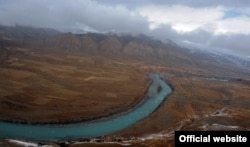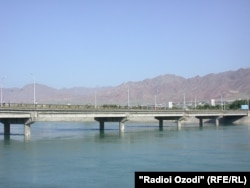The Naryn River starts in eastern Kyrgyzstan's high mountains and flows hundreds of kilometers downstream to meet the Kara Darya and form Central Asia's longest river, the Syr Darya.
The Syr Darya features prominently in Central Asian history and its importance today for the four countries it passes through would be difficult to overestimate. That fact is starkly obvious this year as Central Asia faces a severe drought that has ruined crops and killed livestock.
But while many reports on the Naryn and the Syr Darya river system focus on the volume of water it carries and how that resource is used for agriculture, far less attention is given to the communities along the banks of the rivers -- which wind more than 2,200 kilometers to the Kyzylkum Desert.
"By securitizing water relations, Central Asian governments emphasize what divides people rather than the many common interests they share," said Aibek Samakov of Kyrgyzstan, a creator of the Naryn-Syr Darya online project.
The multilingual website he helped create draws on the experiences of five communities along the rivers -- the city of Naryn and village of Shamaldy-Sai in Kyrgyzstan, the city of Ferghana in Uzbekistan, Khujand in Tajikistan, and Kazaly in the Kyzylorda Province of Kazakhstan.
Samakov said it's vitally important for the people living along the rivers to understand the commonalities most of the Naryn and Syr Darya riparian communities face.
For instance, downstream communities tend to blame upstream residents for water shortages, but in many cases the upstream communities also suffer from a lack of water.
Water usage is also changing as communities along the banks of the Naryn and Syr Darya rivers expand and modernize, increasing demand.
Small agricultural communities usually try to keep the river water free of pollution, but in the growing towns and cities -- where increasingly more people own cars -- the river’s water is often used to wash vehicles, and the soapy water ends up in the river.
Unwritten Rules
It's not widely known that there are also unwritten rules for accessing the river in parts of Tajikistan where women are prevented from wearing bathing suits. As a result, many of them never learn to swim -- one reason why many more Tajik women than men drown.
One of the biggest problems caused by the overuse of water from the Syr Darya is the environmentally and economically destructive desiccation of the Aral Sea.
Much of that catastrophic problem is due to the immense amount of water used in the cotton, rice, and wheat fields. Instead of planting something else, exports of these thirsty crops actually grew between 1989 and 2016 while the Aral Sea continued to shrink.
The construction of bridges also brings changes to the habitation along the rivers as communities on either side tend to expand, with trade also growing at these crossing points.
In the case of Tajikistan’s second-largest city -- Khujand -- the construction of two bridges in the 1960s opened up the development of the right bank of the Syr Darya, land that had previously been considered uninhabitable.
Bridges also create conflicts over taxation and fees, or arbitrary decisions by officials on one side to close off traffic, which happened in 2000 when Uzbek officials not only closed the bridge connecting the Uzbek town of Uch-Kurgan to the Kyrgyz town of Kyzyl-Jar, but even went so far as to dismantle the bridge to prevent the prospect of Islamic Movement of Uzbekistan militants crossing into Uzbekistan.
Conversely, when communities cooperate to maintain bridges it can bring together residents on both sides of the river in some areas where deadly ethnic conflicts have sprung up.
These are just some of the difficult problems faced by the people -- as well as local officials -- along Central Asia's great rivers.











